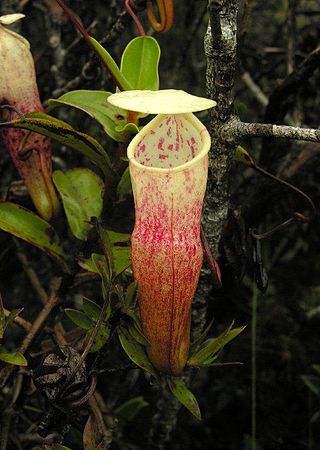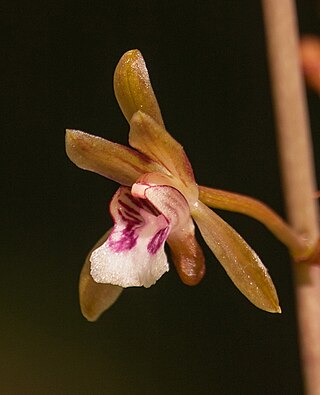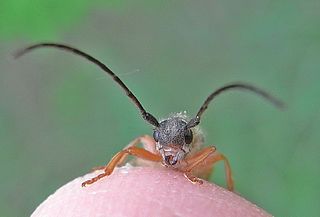
Nepenthes benstonei is a tropical pitcher plant endemic to Peninsular Malaysia, where it grows at elevations of 150–1350 m above sea level. The specific epithet benstonei honours botanist Benjamin Clemens Stone, who was one of the first to collect the species.

Nepenthes gracillima is a highland Nepenthes pitcher plant species, native to Peninsular Malaysia.

Nepenthes ramispina is a highland Nepenthes pitcher plant species, native to Peninsular Malaysia. It was once regarded as being similar to N. gracillima, but studies of the two species in nature have shown that they are readily distinguishable in isolation, N. gracillima being far more readily confused with N. macfarlanei in its rosette stage.

Nepenthes alba is a tropical pitcher plant endemic to Peninsular Malaysia. The specific epithet alba is derived from the Latin word albus, meaning "white", and refers to the colour of the upper pitchers.

Myriopteris gracillima, formerly known as Cheilanthes gracillima, is a species of lip fern known by the common name lace lip fern. It is native to western North America, where it grows in rocky habitat from British Columbia to California to Montana.

Oberea is a genus of longhorn beetles, most of which are stem borers of various plants, including blackberries and their relatives.
Thiseltonia is a genus of Australian plants in the daisy family Asteraceae. It is placed in the pussy's-toes tribe Gnaphalieae. As of June 2023, the Global Compositae Database and Florabase accepted only one species, Thiseltonia gracillima, native to Western Australia, and regarded Thiseltonia dyeri as a synonym, while Plants of the World Online accepted Thiseltonia dyeri as a separate species.

Najas gracillima, the slender waternymph, is a submerged species of aquatic plant in the Hydrocharitaceae family. found in lakes and streams. It is native to China, Russian Far East, Japan, Korea, Taiwan, Iran, Alberta, Ontario, Newfoundland, Nova Scotia, New Brunswick, the eastern United States. It is also considered introduced and naturalized in France, Spain, Italy and California.

Oeceoclades gracillima, sometimes known in horticulture by the synonym Oeceoclades roseovariegata, is a terrestrial orchid species in the genus Oeceoclades that is endemic to Madagascar. It was first described by the German botanist Rudolf Schlechter under the illegitimate name Eulophia gracillima in 1913. Schlecter later validly republished the species under the name Eulophidium gracillimum in 1925. It was then moved to the genus Oeceoclades by Leslie Andrew Garay and Peter Taylor in 1976.
Oberea bisbipunctata is a species of flat-faced longhorn beetle in the tribe Saperdini in the genus Oberea, discovered by Maurice Pic in 1916.
Oberea consentanea is a species of beetle in the family Cerambycidae. It was described by Francis Polkinghorne Pascoe in 1867. It is known from Borneo.
Oberea neavei is a species of beetle in the family Cerambycidae. It was described by Per Olof Christopher Aurivillius in 1914.
Oberea erythrostoma is a species of beetle in the family Cerambycidae. It was described by Heller in 1915. It is known from the Philippines.

Oberea euphorbiae is a species of beetle in the family Cerambycidae. It was described by Ernst Friedrich Germar in 1813 originally under the genus Saperda. It has a wide distribution in Europe. It feeds on Euphorbia palustris.
Oberea ferruginea is a species of beetle in the family Cerambycidae. It was described by Thunberg in 1787.

Oberea linearis is a species of beetle in the family Cerambycidae. It was described by Carl Linnaeus in 1761, originally under the genus Cerambyx. It has a wide distribution throughout Europe. It is preyed upon by Opilo pallidus, and serves as a host for the parasitic wasp species Dolichomitus messor and Phaenolobus terebrator. It feeds on Juglans regia, Corylus avellana, Ulmus glabra, Ostrya carpinifolia, and Carpinus betulus. It contains the varietas Oberea linearis var. parallela.
Oberea nigriventris is a species of beetle in the family Cerambycidae. It was described by Henry Walter Bates in 1873. It is known from Malaysia, Japan, Laos, Vietnam, China, Myanmar, and Taiwan.

Carex gracillima, called the graceful sedge or purple-sheathed graceful sedge, is a species of flowering plant in the genus Carex, native to central and eastern Canada and the central and eastern United States. It prefers to grow in shady, wet woodlands and similar habitats.










